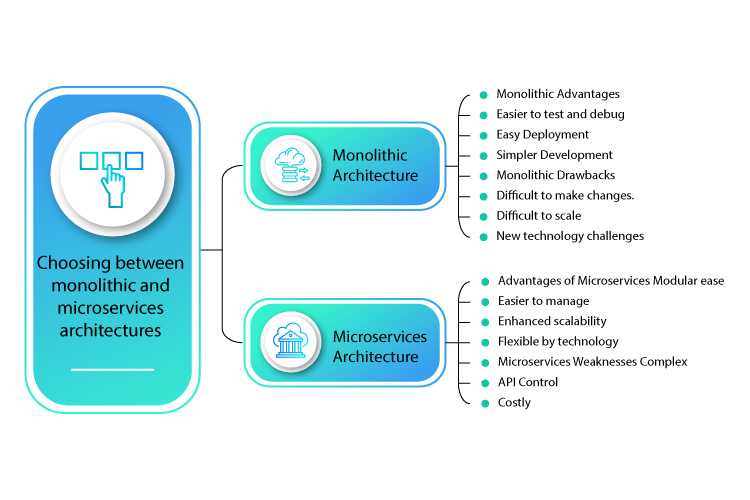
The speed with which the microservice architecture has become popular is not surprising, given its many advantages in terms of better scalability, flexibility and agility. Several mammoth tech leaders—Netflix, Google and Amazon, among them—have already moved from a traditional monolithic architecture to micro services. But there are definitive use cases when micro services may not be the best solution. For instance, with small enterprises or start-ups that may not be able to employ the resources required to deal with the complexities that come with micro services, or when building a simple application. In both these instances, the traditional monolithic architecture is the smarter option.
Nevertheless, the trend of building monolithic applications is seeing a definite slow down, thanks to the many challenges it poses, including large code base, new technology adoption challenges, scalability, deployment, and feature update challenges, among others.
The big question ultimately is: which architecture will help you accomplish your business goals?
To answer this question, this post takes a closer look at both monolithic and microservices to understand the pros and cons of each and where each fits best.
Monolithic Architecture
The traditional approach to building applications, monolithic apps are built as single integral units. Such applications generally consist of a client-side interface, the server-side application and a database. All its functions are managed in on place. Given its nature, monolithic applications have one big code base, and are not modular. This means that if any update has to be made or a change is needed, the developers must access the same code base. I.e. making changes in the entire stack for every change they need to make.
Monolithic Advantages
Fewer cross-cuttings. Since there is only one application to consider the problem of cross-cutting concerns—these relate to external configuration, logging, health check and cross-cutting concerns that relate to the specific technologies used by the microservices.
Easier to test and debug
Monolithic applications are single indivisible units. As a result, it is simpler to run end-to-end testing,
Easy Deployment
As you don’t have to handle multiple deployments—I.e. only one file or directory—monolithic applications are relatively easier to deploy
Simpler Development
With fundamental knowledge and capabilities, almost any development team can build a monolithic app—taking a standardized approach to application building
Monolithic Drawbacks
Scale brings complexity
As long as the app remains relatively simple, everything works well, but as it scales, it can become complicated, and it can be hard to manage a complex code system in a single application.
Difficult to make changes.
Since any change in code will affect the entire system, it needs to be well planned and coordinated. The makes the entire process of development more complicated and takes longer
Difficult to scale
Individual components cannot be scaled in a monolithic app. The entire application needs to be scaled. This can be problematic.
New technology challenges
Applying a new technology to a monolithic application can be very difficult as the entire app needs to be recreated.
MICROSERVICES
In contrast to the monolithic architecture, a microservices architecture is a union of several independent units each dedicated to doing one service and doing it well. Thus, each individual service has its own logic and database. These microservices interact with each other through Application Programming Interfaces (API).
Advantages of Microservices
Modular ease
Microservices are designed for discrete development, updation and deployment. Being modular in nature, individual microservices are not affected by a bug in another microservice. By the same token it is easier to isolate problems and add new features. I.e lower downtime.
Easier to manage
As microservices applications function as a cohesive grouping of smaller yet complete units, they are relatively simple to understand and to manage.
Enhanced scalability
Whereas monolithic apps need to be scaled as a single unit, microservices allow you to scale specific elements separately. This is a much more cost-effective and efficient process. Another issue with monolithic scalability is that is becomes more difficult and complex as the number of users grow. Beyond a point, you may have to rebuild the entire monolith.
Flexible by technology. Unlike monolithic architectures, microservices applications can use diverse technologies. This gives them a significant edge in performance over monolithic apps, which are restricted to using one technology. Any change means rewriting the entire app.
Microservices Weaknesses
Complex
Microservices architectures are a modular distributed system that requires you to connect multiple different modules, each running a different process and connected to a discrete database. Not only is this a complex system comprising different independent modules and databases, the connections have to be planned and executed carefully, so the application runs smoothly
API Control
Microservices communicate via API, which need to be consistent. So while changes can be easily made to a micro service, if the API is changed it will affect every application using that micro service. Since any single application comprised multiple microservices and their attendant APIs, interface control is of primary importance.
Costly
Microservices increase costs as they need sufficient hosting infra plus security, support and expert developers who can manage the services. Organizations running monolithic architectures will need to invest up front in this new infrastructure and resources before they can move to microservices.
Finding the Best-Fit Architecture for Your Needs
Choosing the best architecture depends a lot on your organization’s own structure, size, and objectives. Read on to understand which approach will best meet your requirements.
Consider choosing monolithic architectures, if:
- You have a small team, with fewer business needs
- You’re working on a small application that doesn’t call for high scalability, or flexibility
- Have limited access to technical expertise
- Need to launch your application quickly (proof of concept)
Consider going with a microservices architecture, if:
- Your team has the extensive skill and knowledge base to build and maintain a microservice application—this includes DevOps & Containers expertise too.
- You’re building a large application with many moving parts. The modular nature of microservices will allow easy scalability, and make it relatively easy to make changes/add new functionalities as and when needed
- Your application has a growing user base and multiple development teams may be required to work simultaneously on different services.
There is a huge and growing shift to microservices architecture, but it is important to take your organization’s requirements into account before making a decision. If you need help making a decision, Teleglobal’s experts can help. Get in touch with us today.







































